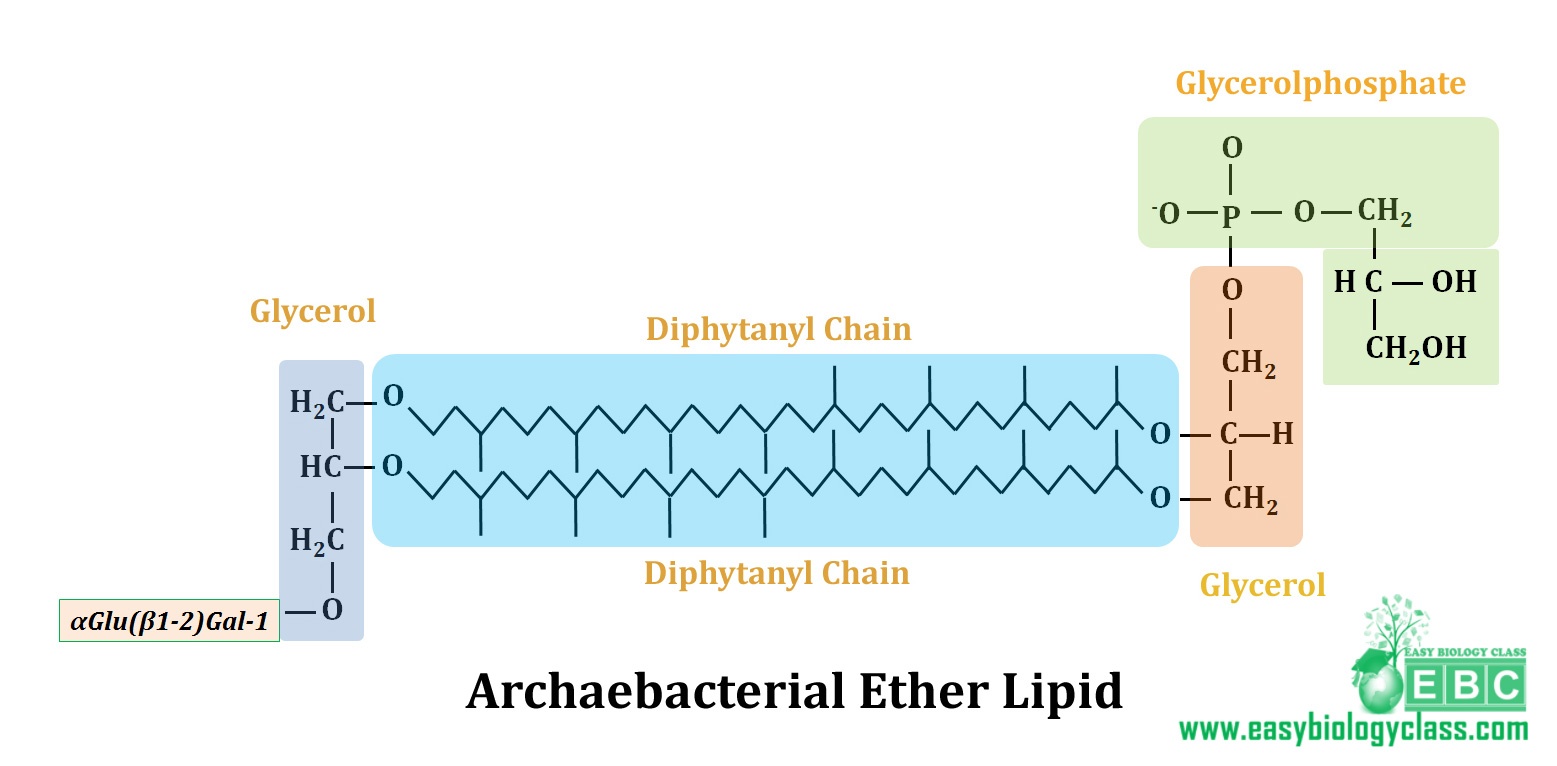“Good fences make good neighbors”
Robert Frost, “Mending Wall”, 1914
Biological membrane system: Biological membranes are highly dynamic two layers thick sheath like structures formed by the non-covalent assemblage of lipids, proteins and carbohydrates. They form closed boundaries between different compartments of the cells such as separation of nucleoplasm from the cytoplasm by nuclear membrane in all eukaryotes. They act as barriers to the passage of polar molecules and ions.
The thickness of membrane varies among different classes of organisms and the average width ranges from 60 Å (6 nm) to 100 Å (10 nm) in most of the cases.
Even though membrane contains carbohydrates and proteins, the major structural components of bio-membrane are a special class of lipids called membrane lipids. In storage lipids (triglycerides) the three –OH groups of glycerol moieties are esterified by three fatty acids and thus they are completely non-polar. However in membrane lipids, the hydroxyl group at C1 and C2 are esterified with fatty acids and the remaining third –OH group (at C3) will combine to a polar molecule. Thus membrane lipids are amphipathic because they have hydrophilic head (polar) at one end and hydrophobic tail (nonpolar) at the other end. The long hydrocarbon chain of fatty acids forms the hydrophobic part. The hydrophilic moieties of membrane lipids are of different types and which may be as simple as –OH or may be much complex like carbohydrates or amino acids or their derivatives. We commonly call the polar part of membrane lipid as ‘Head’ group and the nonpolar part as ‘Tail’ group.
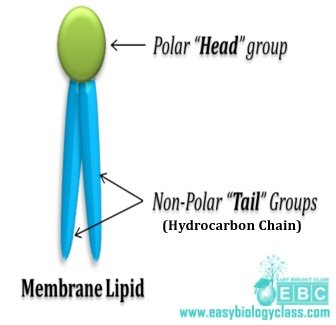
 .
.
The hydrophobic interactions of the nonpolar parts among themselves and the hydrophilic interaction with water are responsible for the packing of lipids in the membrane. These hydrophilic and hydrophobic interactions are also responsible for the bilayer organization of membranes in the cells.
Classification of membrane lipids:
Membrane lipids are classified based on the properties of ‘Head’ group. The membrane lipids of Prokaryotes, Eukaryotes and Archaebacteria are grouped into four major categories:.
1. Phospholipids
2. Glycolipids
3. Sterols
4. Archaebacterial ether lipids
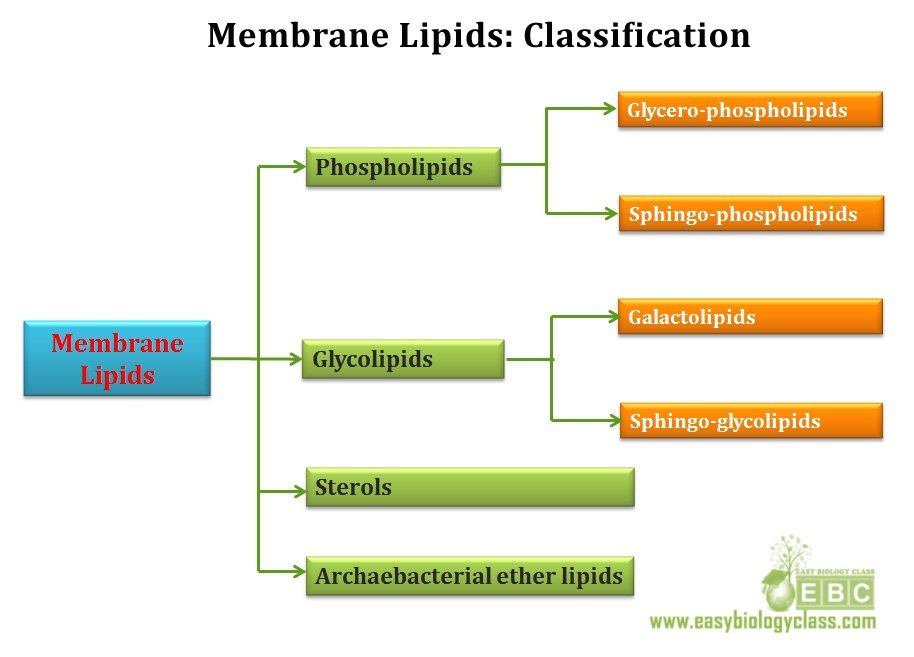
.(1). Phospholipids:
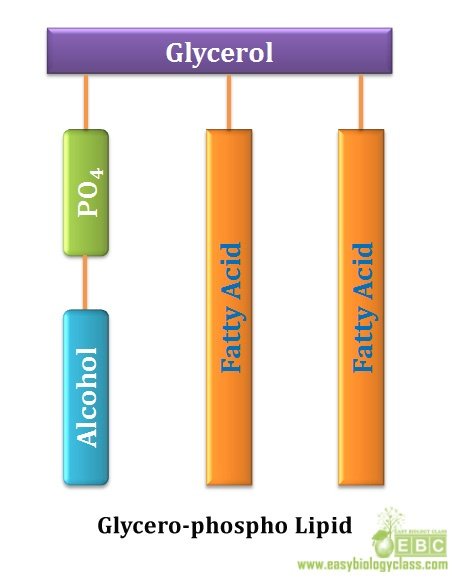
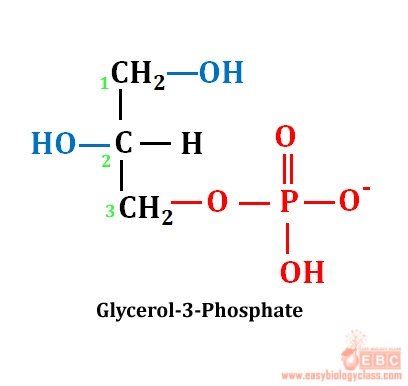
Glycerol-3-phosphate is the backbone of all phospholipids. Here a polar ‘head’ group is joined to the hydroxyl (-OH) group of the C3 of a glycerol by a phosphodiester linkage. The other two –OH groups (C1 and C2) of the glycerol are esterified by fatty acids (R1 & R2)..
There are two sub categories of phospholipids:
(1.A). Glycero-phospholipids
(1.B). Sphingo-phospholipids.
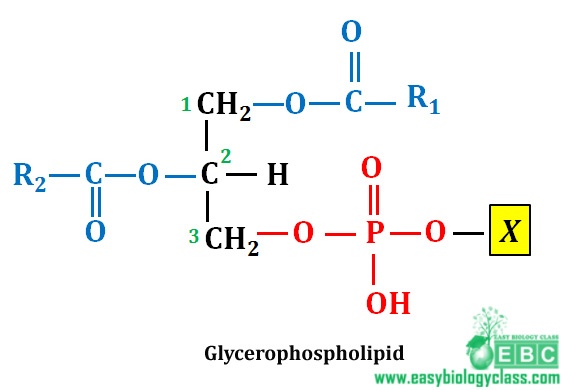
(1.A). Glycero-phospholipids:
They are also called as phosphoglycerides and are one of the major lipid components of biological membrane. They consist of glycerol-3-phosphate backbone, whose C1 & C2 are esterified by fatty acids and the C3 is linked to a polar head through a phosphate group. The polar head group (-X in the image) may be as simple as a hydrogen (–H) as in the case of phosphatidic acid or it may be much complex as in the case of sphingolipids. The following table shows different glycerol-phospholipids of membrane and the nature of its head group (-X).
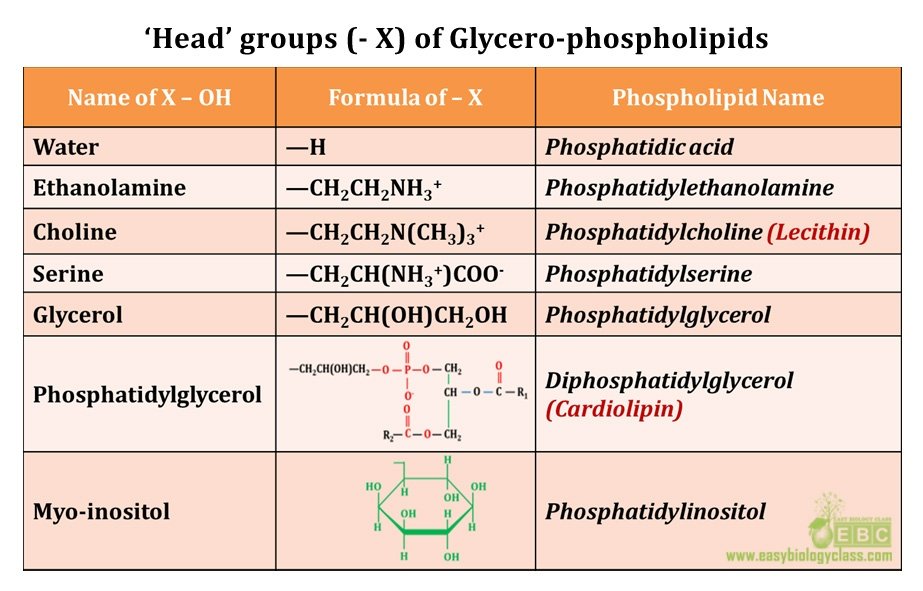 .
.
Cardiolipin: It is a complex glycero-phospholipid whose polar head group (-X) is a phosphatidylglycerol and thus structurally it is a diphosphatidylglycerol. Cardiolipin is an important component of the inner mitochondrial membrane of eukaryotes. It constitutes about 20% of the total lipids of inner mitochondrial membrane. Cardiolipin is generally absent in other membranes of eukaryotes including the outer membrane of mitochondria. Thus they are considered as the lipid-marker of inner mitochondrial membrane. (Please remember the enzyme succinate dehydrogenase, which also known as the marker of inner mitochondrial membrane). Bacterial membranes are the only other place where we can find cardiolipin. Thus the presence of cardiolipin in the mitochondrial inner membrane is a strong evidence for endosymbiont theory of the origin of mitochondria in eukaryotes. 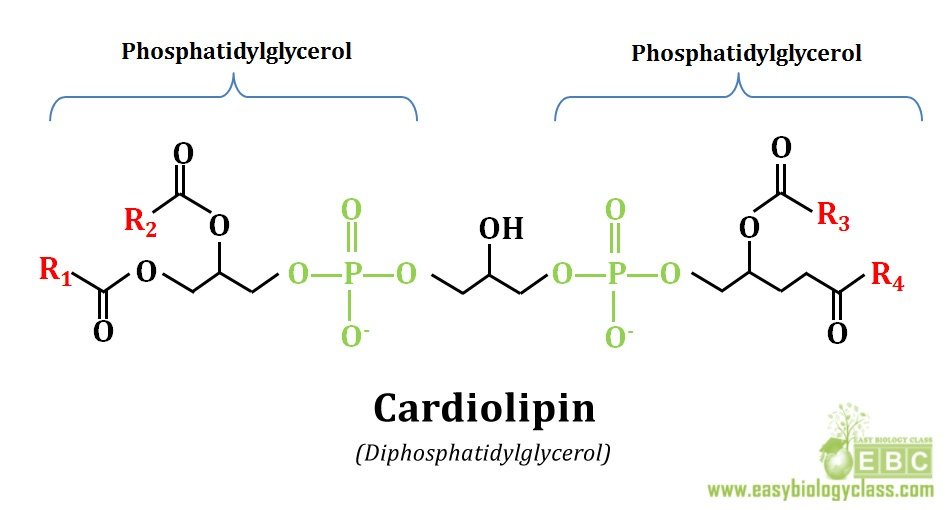
.
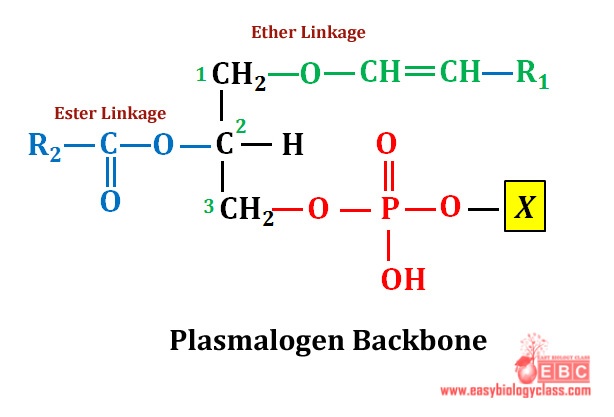 Plasmalogen: They are a class of glycerol-phospholipid in which the C1 of glycerol moiety is linked to a fatty acid via an α, β-unsaturated ether linkage rather than an ester linkage. The head group of plasmalogen may be ethanolamine or choline. In humans they are abundantly present in neurons and cells of cardiovascular system. About 30-40% choline glycero-phospholipids of human heart tissue are plasmalogens. The exact function of plasmalogen is not well understood.
Plasmalogen: They are a class of glycerol-phospholipid in which the C1 of glycerol moiety is linked to a fatty acid via an α, β-unsaturated ether linkage rather than an ester linkage. The head group of plasmalogen may be ethanolamine or choline. In humans they are abundantly present in neurons and cells of cardiovascular system. About 30-40% choline glycero-phospholipids of human heart tissue are plasmalogens. The exact function of plasmalogen is not well understood.
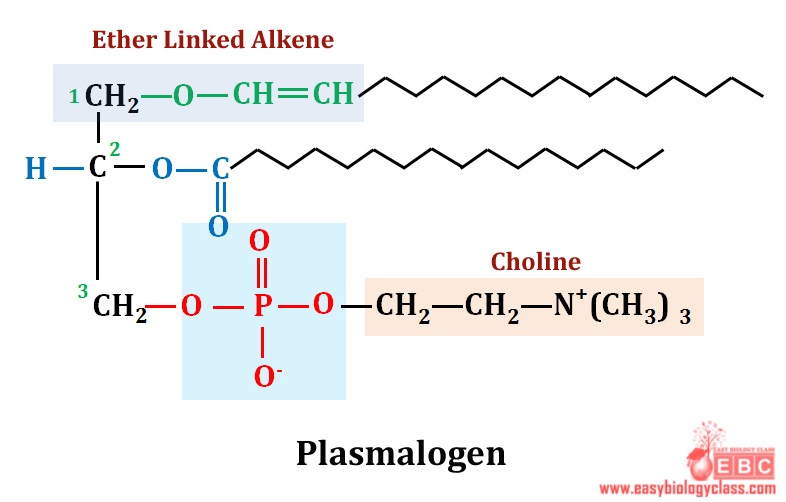
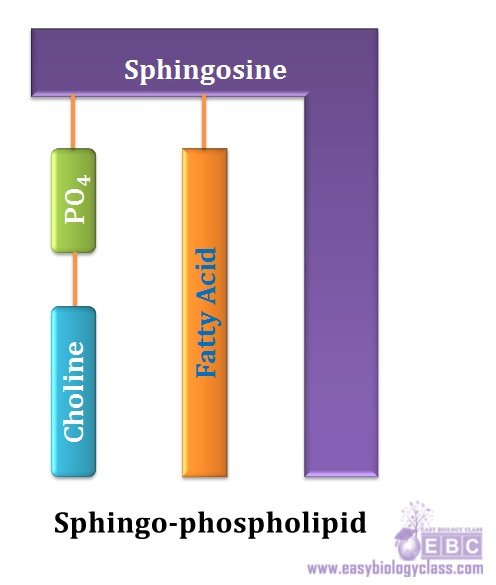 .
.
(1.B). Sphingo-phospholipids:
Sphingolipids are the second sub-category of phospholipids. Sphingolipids are so named based on the Sphinx of Egypt because of their function in the cells was mysterious when they were first discovered. They are present in the membranes of both prokaryotes and eukaryotes.
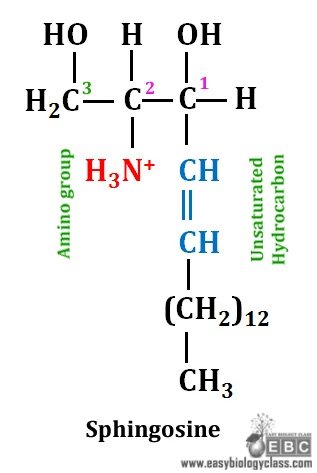 Characteristic feature of sphingolipids is that they have a C18 amino alcohol called Sphingosine backbone instead of the glycerol backbone of other lipids. Sphingosine has a long unsaturated hydrocarbon chain at C1, a protonated amino group (NH3+) at C2 and hydroxyl group at C3. The N-acyl fatty acid derivative of sphingosine at C2 is called as ceramide. Thus ceramide forms the backbone of sphingolipids. Sphingolipids are present both in phospholipids and glycolipids. For easy understanding first we will study sphingo-phospholipids in which the ceramide is esterified with other polar molecules through a phosphate group at C1. .
Characteristic feature of sphingolipids is that they have a C18 amino alcohol called Sphingosine backbone instead of the glycerol backbone of other lipids. Sphingosine has a long unsaturated hydrocarbon chain at C1, a protonated amino group (NH3+) at C2 and hydroxyl group at C3. The N-acyl fatty acid derivative of sphingosine at C2 is called as ceramide. Thus ceramide forms the backbone of sphingolipids. Sphingolipids are present both in phospholipids and glycolipids. For easy understanding first we will study sphingo-phospholipids in which the ceramide is esterified with other polar molecules through a phosphate group at C1. .
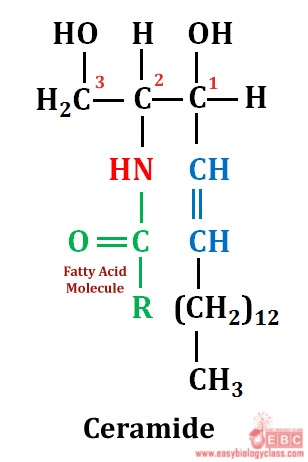
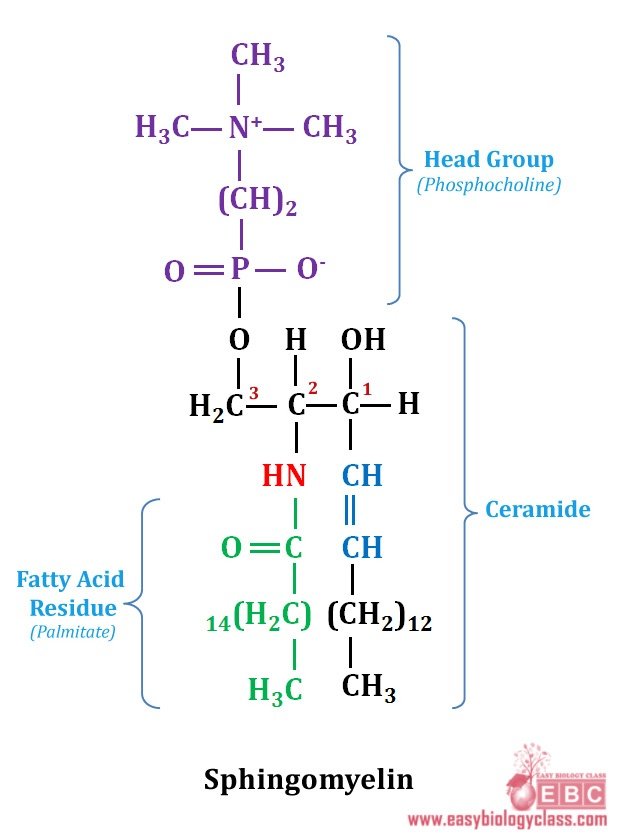 Sphingomyelin: They are the most common sphingo-phospholipids. They constitute about 10 – 20% of plasma membrane lipids of the cells. The head group may be a phosphocholine or a phosphoethanolamine. Myelin sheath of nerve cell axons is particularly rich in sphingomyelins
Sphingomyelin: They are the most common sphingo-phospholipids. They constitute about 10 – 20% of plasma membrane lipids of the cells. The head group may be a phosphocholine or a phosphoethanolamine. Myelin sheath of nerve cell axons is particularly rich in sphingomyelins
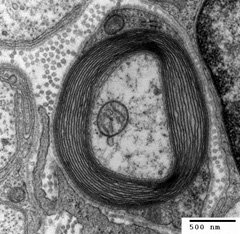 (Figure above) Electron microscopic image of cross section of a myelinated nerve cell: Note the spirally wrapped membrane around each nerve axon. Myelin sheath may be 10 -15 layers thick and the high lipid content makes it an electrical insulator
(Figure above) Electron microscopic image of cross section of a myelinated nerve cell: Note the spirally wrapped membrane around each nerve axon. Myelin sheath may be 10 -15 layers thick and the high lipid content makes it an electrical insulator
.
(2). Glycolipids:
They are the second major category of membrane lipids in which the polar head group holds one or more carbohydrate moieties and its derivatives. Besides in the membrane, the lipids conjugated with carbohydrates may have two other important roles such as (a) provide energy and (b) act as markers for cellular recognition.
Classification of Glycolipids:
Glycolipids are classified into two sub categories:
(2.A). Glyceroglycolipids
(2.B). Sphingo-glycolipids
Glyceroglycolipids have glycerol backbone with carbohydrate heads. Galactolipids and sulfolipids are the two important glyceroglycolipids. 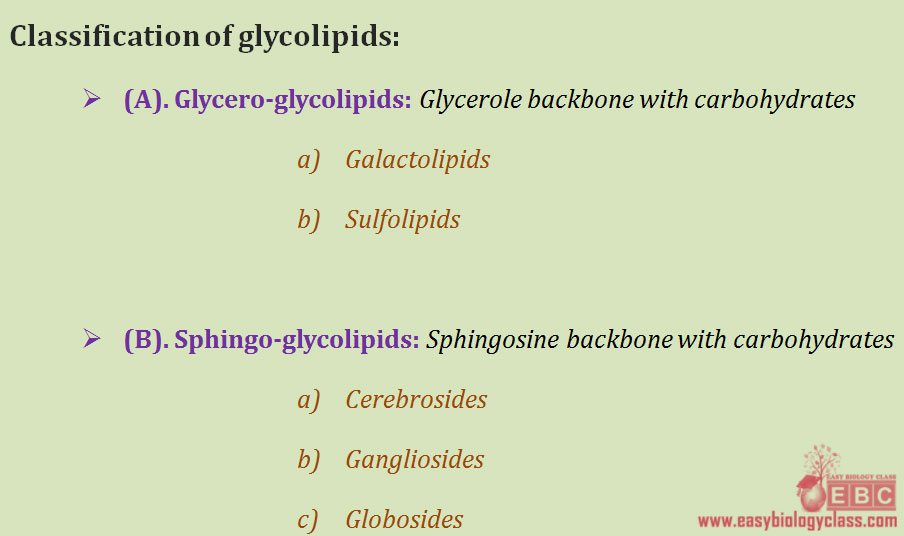 .
.
(2.A.a). Galactolipids:
In galactolipids the C3 of the glycerol moiety is connected to one or more galactose residues by glycosidic linkages. The C1 and C2 of glycerol are esterified with fatty acids. Galactolipids are predominantly present in the membranes of plant cells. They are particularly abundant in thylakoid membranes of chloroplasts. Galactolipids constitute about 70 to 80% of plant membrane lipids and thus they are probably the most abundant membrane lipids in the biosphere. Monogalactosyldiacylglycerol (MGDG) and Digalactosyldiacylglycerol (DGDG) are the two important galactolipids of chloroplasts. 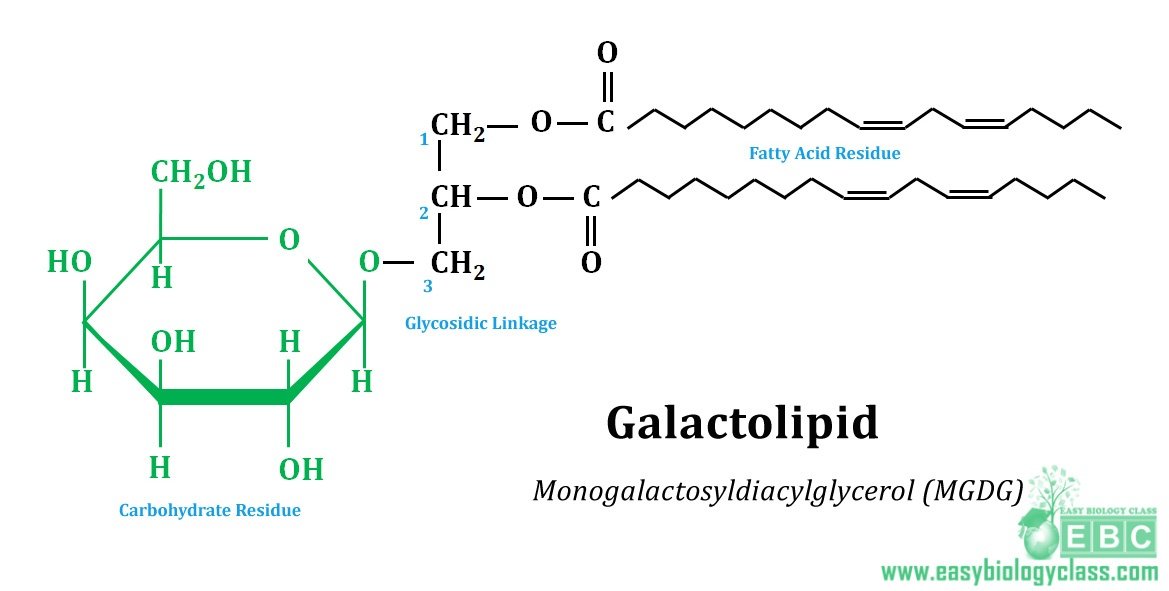
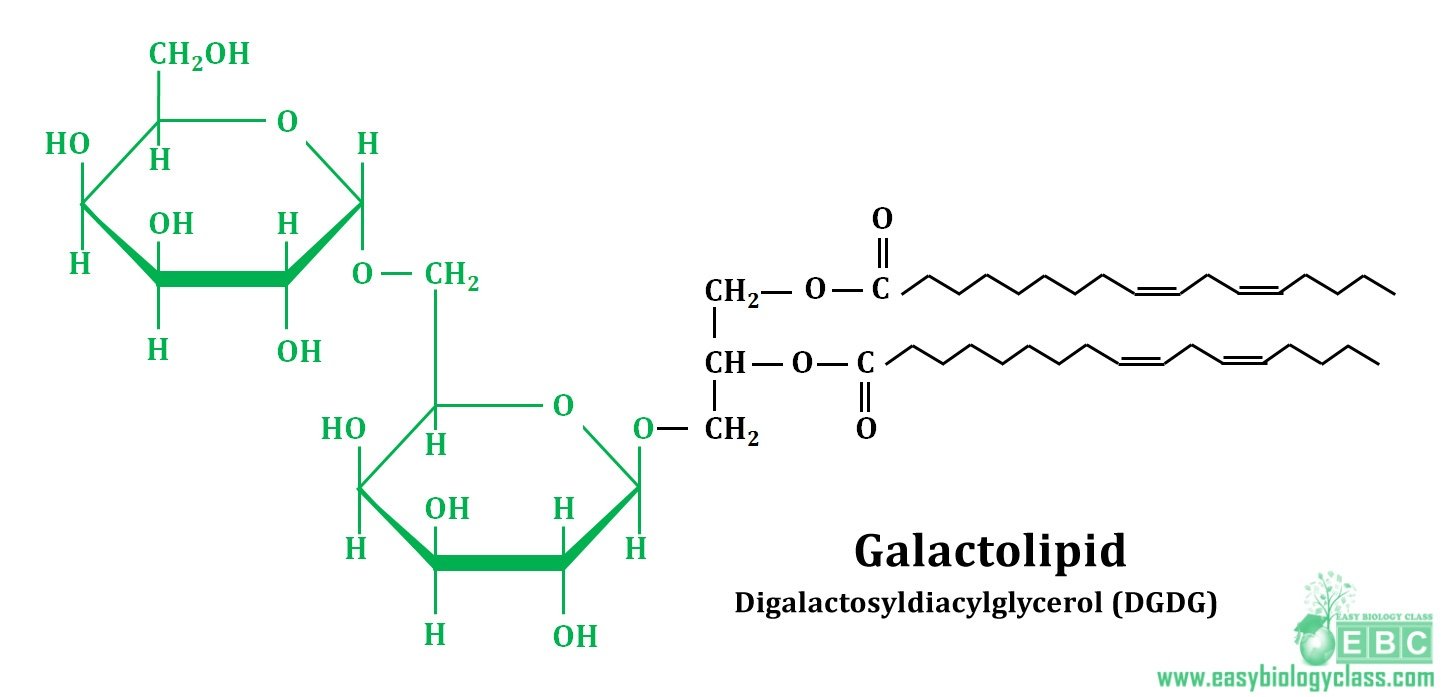 .
.
(2.A.b). Sulfolipids:
They are membrane glycolipids with sulfur containing functional groups. Sulfonated glucose is joined to the C3 of diacylglycerol in glycosidic linkage. Plant membranes are also rich in sulfolipids. The sulfonated head group of sulfolipid holds a negative charge like that of the phosphate group in phospholipids. 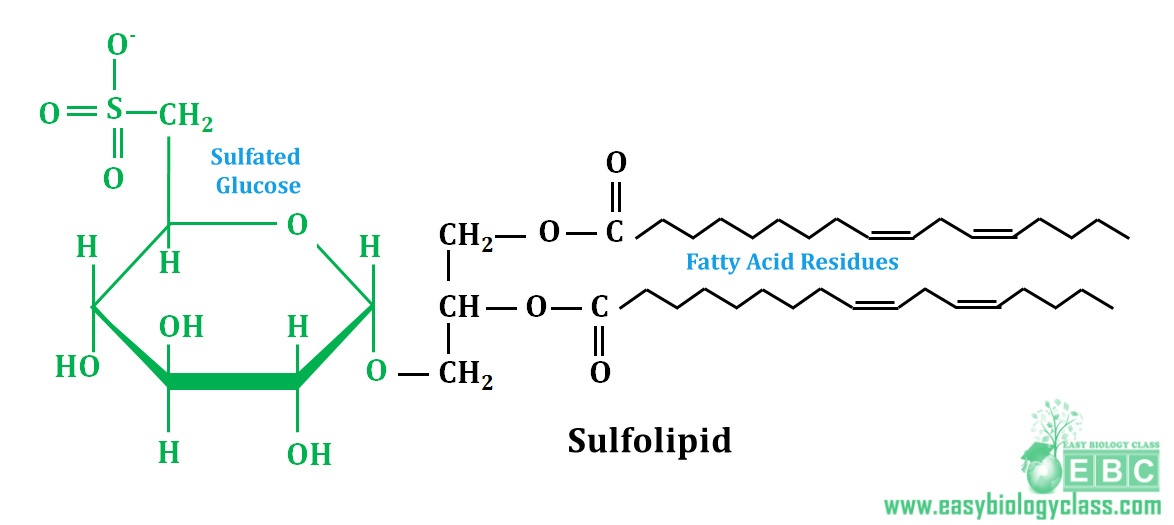 (2.B). Sphingo-glycolipids:
(2.B). Sphingo-glycolipids:
They are glycolipids with ceramide (N-acyl fatty acid derivative of sphingosine) backbone rather than the glycerol moieties. The C3 of ceramide are esterified with carbohydrates to form the head group. There are many classes of sphingo-glycolipids, among which the following three categories are most important in membrane system.
1. Cerebrosides
2. Globosides
3. Gangliosides
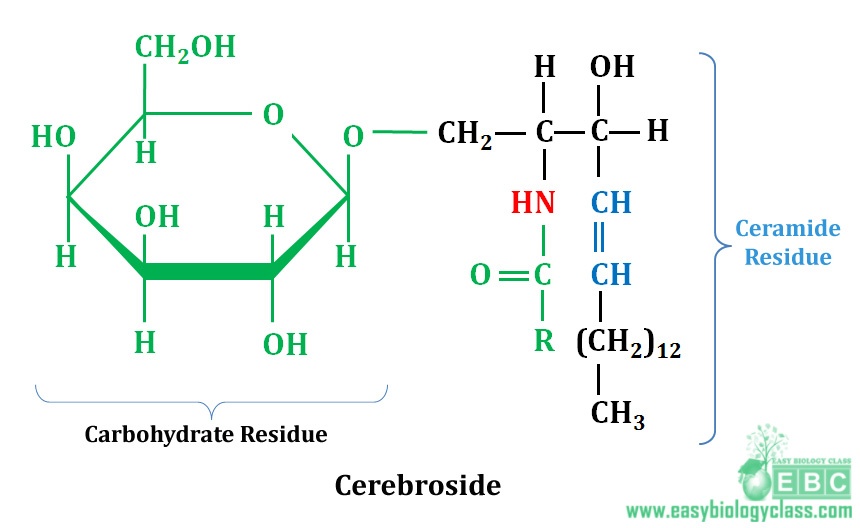
(2.B.a). Cerebrosides:
It is a ceramide with single sugar residue at the C1-hydroxyl group. The sugar residue of cerebrosides may be either glucose or galactose and thus there are two categories of cerebrosides namely glucocerebrosides and galactocerebrosides. Cerebrosides lack the phosphate group and thus they do not hold any charge (non-ionic). Cerebrosides are abundantly found in the cell membranes of nerves and muscles of animals. Nerve cell membranes are particularly rich in galactocerebrosides whereas glucocerebrosides are abundant in other tissues. .
(2.B.b). Globosides:
They are sphingo-glycolipids with more than one sugar as the side chain of a ceramide. They are different from gangliosides since they lack the sialic acid residues. The carbohydrate moieties are usually a combination of N-Acetyl-galactosamine, D-glucose or D-galactose. 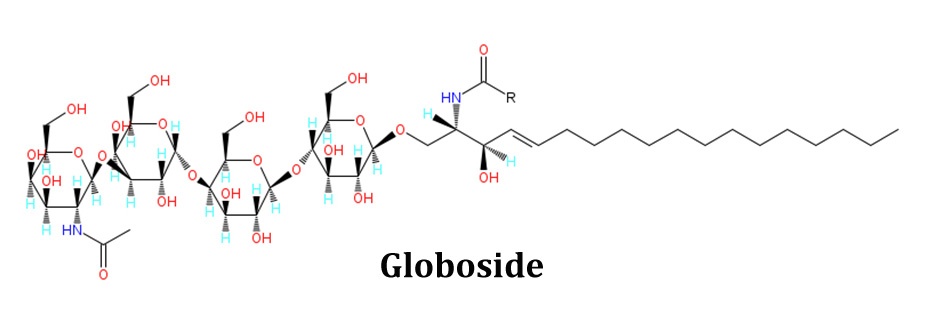 .
.
(2.B.c). Gangleosides:
Gangliosides are membrane lipid with most complex structure. It is a glyco-sphingolipid with many carbohydrate moieties and one or more sialic acids linked on the sugar chain. About 6% of brain lipids are gangliosides and they are first isolated from the ganglion of brain cells. Gangliosides are also abundant in the lipid rafts of plasma membrane.
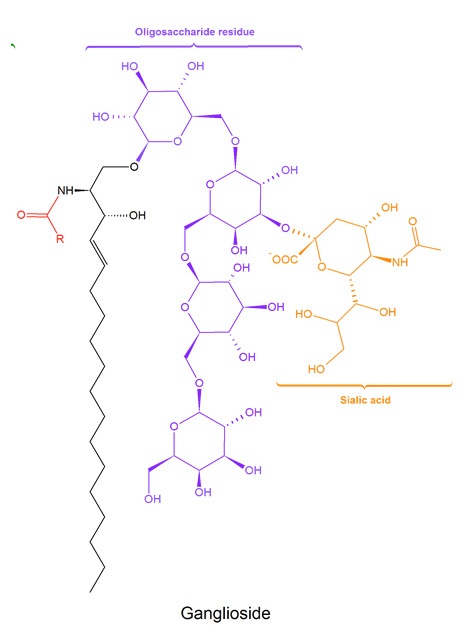 Gangliosides have considerable physiological and medical significance in our body. They act as specific receptors for glycoprotein hormones in the cells. Some gangliosides also serve as receptors for some bacterial protein toxins such as cholera toxin of Vibrio cholerae and heat-labile enterotoxin of E. coli both causing diarrhea in humans in more or less similar mechanism. (Cholera toxin is an oligomeric proteinaceous toxin with six sub-units secreted by the virulent strains of Vibrio cholerae. Cholera toxin binds to the GM1 gangliosides on the surface of target cells). Gangliosides also help in cell-cell recognition and thus have a significant role in growth and differentiation of tissues and also in carcinogenesis. Tay-Sachs disease is a hereditary disorder caused by the breakdown of gangliosides, leading to fatal neurological deterioration in the early childhood..
Gangliosides have considerable physiological and medical significance in our body. They act as specific receptors for glycoprotein hormones in the cells. Some gangliosides also serve as receptors for some bacterial protein toxins such as cholera toxin of Vibrio cholerae and heat-labile enterotoxin of E. coli both causing diarrhea in humans in more or less similar mechanism. (Cholera toxin is an oligomeric proteinaceous toxin with six sub-units secreted by the virulent strains of Vibrio cholerae. Cholera toxin binds to the GM1 gangliosides on the surface of target cells). Gangliosides also help in cell-cell recognition and thus have a significant role in growth and differentiation of tissues and also in carcinogenesis. Tay-Sachs disease is a hereditary disorder caused by the breakdown of gangliosides, leading to fatal neurological deterioration in the early childhood..
(3). Sterols:
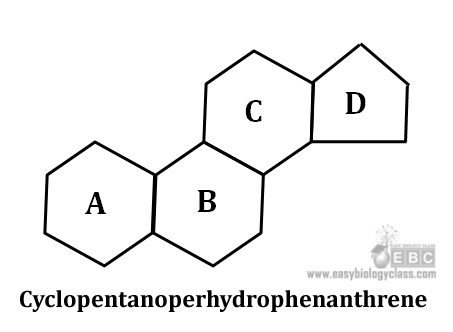 Sterols are the third major category of membrane lipids and are usually present in the membrane of eukaryotic cells. Structurally sterols consist of four fused carbon rings (A, B, C, D) and a hydrocarbon chain (alkyl side chain). Rings A, B and C are six carbon rings whereas the ring D is a five carbons structure. This fused ring structure is called the steroid nucleus. The steroid nucleus of all sterols is derived from a cyclized derivative called cyclopentanoperhydrophenanthrene. One of the peculiarities of carbon in fused ring structure is that it does not allow C – C free rotation even though they are in single bonds.
Sterols are the third major category of membrane lipids and are usually present in the membrane of eukaryotic cells. Structurally sterols consist of four fused carbon rings (A, B, C, D) and a hydrocarbon chain (alkyl side chain). Rings A, B and C are six carbon rings whereas the ring D is a five carbons structure. This fused ring structure is called the steroid nucleus. The steroid nucleus of all sterols is derived from a cyclized derivative called cyclopentanoperhydrophenanthrene. One of the peculiarities of carbon in fused ring structure is that it does not allow C – C free rotation even though they are in single bonds.
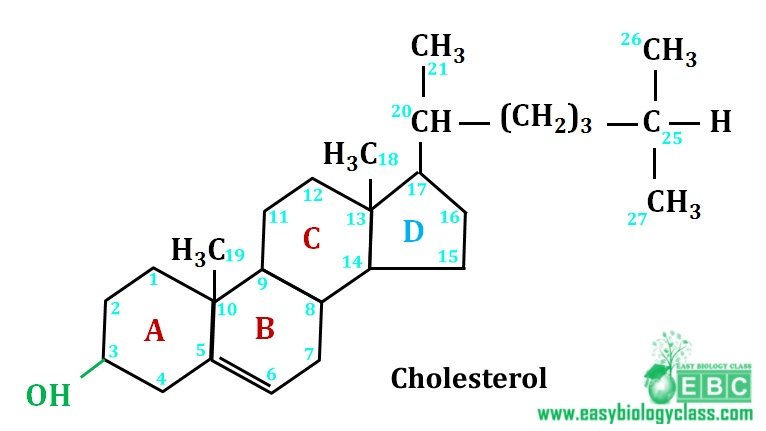
Cholesterol is a major sterol of the membrane of animal cells. They constitute about 30-40% of all membrane lipids in animals. Similar to other membrane lipids, cholesterol is also amphipathic with single polar hydroxyl (-OH) ‘head’ and non-polar hydrocarbon ‘tail’. The –OH group and hydrocarbon chain are attached to the C3 and C17 of the steroid nucleus respectively. Cholesterol can esterify with long chain fatty acids to form cholesterol esters such as cholesteryl stearate..
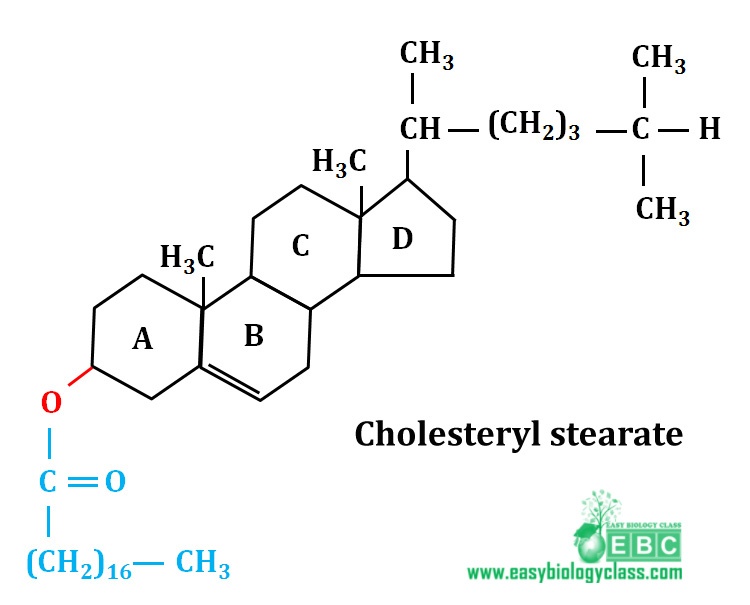
In mammals, cholesterol also acts as the metabolic precursor of steroid hormones such as testosterone. Cholesterol is generally absent in plant cell membrane. However other sterols do occur in plants. Sterols of plants are commonly known as phytosterols. Stigmasterol is an important membrane sterol of plant cells. Campesterol and sitosterol are other plant membrane sterols. Sterols are also present in the membranes of fungi. Ergosterol is the most common fungal sterol. In animals and fungi, lanosterol acts as the precursor of sterols whereas as in plants, cycloartenol is considered as the sterol precursor. Both Lanosterol and Cycloartenol are derived from the cyclization of triterpenoid – squalene.
Bacteria are unable to synthesize any of the sterols and thus bacterial membranes are generally free of sterols. However some bacteria can incorporate exogenous sterols in to their membrane..
(4). Archaebacterial ether lipids:
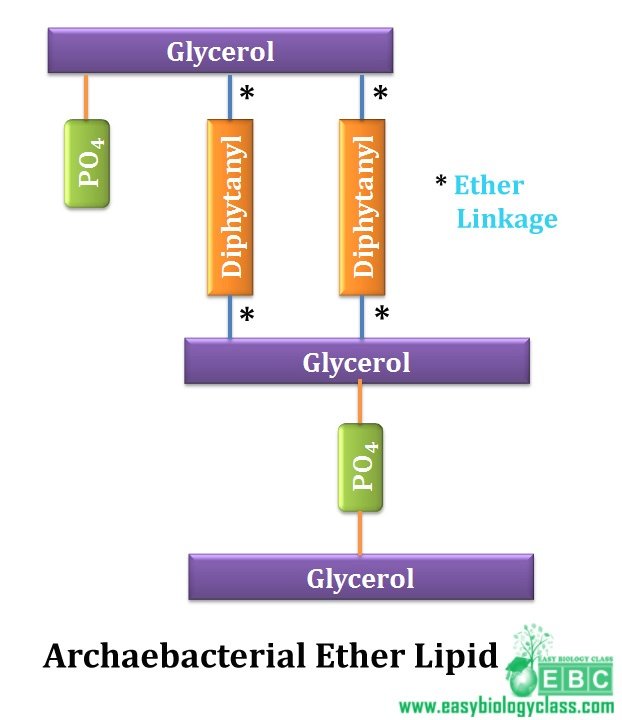 They are the fourth major category of membrane lipids. They are special membrane lipids of archaebacteria and are absent in prokaryotes and eukaryotes. Majority of archaebacteria lives in harsh and extreme environmental conditions such as high temperature, high salinity or high pH. Thus they require more strong and durable membrane lipids than prokaryotes and eukaryotes. Archaebacterial ether lipids consists of long (32C) branched hydrocarbon chains linked at both end to glycerol. The linkage of hydrocarbon chains to the glycerol is through ether bonds (R – O – R’) rather than the usual ester bonds. This may be due to the fact that ether bonds are more stable than ester bonds in harsh environmental conditions such as high temperature and pH. Due to the presence of long hydrocarbon chain, archaebacterial ether lipids are large and twice the length of phospholipids and sphingolipids. They span the entire width of surface membrane since they have polar groups at both ends. At each end of the molecule were the two glycerol moieties are present are further linked to phosphates or sugar residues.
They are the fourth major category of membrane lipids. They are special membrane lipids of archaebacteria and are absent in prokaryotes and eukaryotes. Majority of archaebacteria lives in harsh and extreme environmental conditions such as high temperature, high salinity or high pH. Thus they require more strong and durable membrane lipids than prokaryotes and eukaryotes. Archaebacterial ether lipids consists of long (32C) branched hydrocarbon chains linked at both end to glycerol. The linkage of hydrocarbon chains to the glycerol is through ether bonds (R – O – R’) rather than the usual ester bonds. This may be due to the fact that ether bonds are more stable than ester bonds in harsh environmental conditions such as high temperature and pH. Due to the presence of long hydrocarbon chain, archaebacterial ether lipids are large and twice the length of phospholipids and sphingolipids. They span the entire width of surface membrane since they have polar groups at both ends. At each end of the molecule were the two glycerol moieties are present are further linked to phosphates or sugar residues.